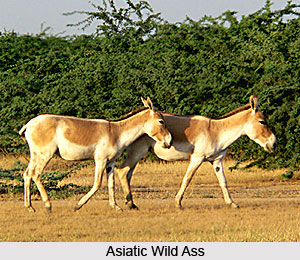 Asiatic Wild Ass animal belongs to the family Equidae, and is a close relation of the Horse and of the African Zebra. It differs from the even-toed Ungulates, which include cattle, deer, and sheep, in being single-hoofed and non-ruminant, i.e. non cud-chewing. Within the subcontinent the wild ass is found only in the Rann of Kutch and has probably only become extinct in Baluchistan within the past forty years. It has a larger cousin, the Kiang, living on the high plateaus of Ladakh and Tibet. The Indian subspecies, khur, stands about 115 cm (48 inches) at the shoulder, therefore considerably taller than the domestic donkey. It is fawn or pale chestnut in colour with a blackish stripe along the ridge of the back. The male is larger and sturdier than the female. They live in mixed troops of 10 to 30 animals for 2 or 3 months after the young are born.
Asiatic Wild Ass animal belongs to the family Equidae, and is a close relation of the Horse and of the African Zebra. It differs from the even-toed Ungulates, which include cattle, deer, and sheep, in being single-hoofed and non-ruminant, i.e. non cud-chewing. Within the subcontinent the wild ass is found only in the Rann of Kutch and has probably only become extinct in Baluchistan within the past forty years. It has a larger cousin, the Kiang, living on the high plateaus of Ladakh and Tibet. The Indian subspecies, khur, stands about 115 cm (48 inches) at the shoulder, therefore considerably taller than the domestic donkey. It is fawn or pale chestnut in colour with a blackish stripe along the ridge of the back. The male is larger and sturdier than the female. They live in mixed troops of 10 to 30 animals for 2 or 3 months after the young are born.
The typical habitat of the Indian wild ass is the flat salt desert around Dhrangadhra and Jhinjuwada in the Little Rann of Kutch. Scanty grasses comprise the principal food of this animal. They also raid rice and wheat cultivation along the edge of the Rann during night and do considerable damage by browsing on the ripening ears of the crop.
The wild ass is a hardy animal and maintains a maximum speed of about 50 kmph over considerable distances when chased by a jeep. They have no serious natural enemies and are normally not molested by local villagers, but within recent years, epidemics like surra and South African Horse Sickness have brought down their population. The Indian wild ass is now included in the Red Data Book of IUCN as an Endangered Species; it has been given total protection under the Indian Wildlife (Protection) Act of 1972, and through effective conservation measures by the Government of Gujarat, the population is happily showing a steady upward trend. Considering their size and sturdiness and their potential as draft animals, efforts have been made to break them in and also to breed mules from them for use in mountain transport by the army, but they have not been successful.



















